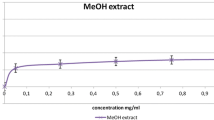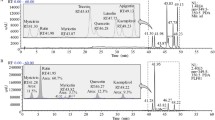Abstract
Natural killer cell (NK) is known as a major immune system in body through mediating cell death via several possible pathways, and one of three subpopulations of lymphocytes functioning as scavenger of tumor, virus infected cells etc. Our present results found that the SOD-contained silkworm larvae powder caused an enhancement of the effect on NK cell cytotoxicity, which implied this material modulated the immune system in mice in vivo. The NK cell activities of S180 tumor modeled mice treated with silkworm powder including SOD were enhanced significantly ranging from 30% to 48%, respectively, compare to a distilled water feeding control and silkworm powder without SOD. Meanwhile, the ConA-stimulated splenocyte proliferation of all three treated groups was higher than that of the control both in T cells or B cells. The average tumor weight of S180 modeled mice treated with doses of SOD-contained silkworm powder was lighter than that of water control showing the tumor inhibition rates (IR) reached to 22.51% to 37%, respectively. In conclusion, these findings demonstrate that administration of silkworm larvae powder containing SOD results in activation of NK cells and immune T-cell and B-cell, suggesting the silkworm larvae powder containing SOD play a positive role in tumor inhibition.

Similar content being viewed by others
References
Oldham R (1983) Natural killer cells: artifact to reality: an odyssey in biology. Cancer Metastasis Rev 2(4):323–336
Middleton D, Curran M, Maxwell L (2002) Natural killer cells and their receptors. Transpl Immunol 10(2–3):147–164
Harty J, Tvinnereim A, White D (2000) CD8+ T cell effector mechanisms in resistance to infection. Annu Rev Immunol 18:275–308
Kawai T, Akira S (2006) Innate immune recognition of viral infection. Nat Immunol 7(2):131–137
Andersen MH, Schrama D, Thor Straten P, Becker JC (2006) Cytotoxic T cells. J Invest Dermatol 126(1):32–41
Boon T, van der Bruggen P (1996) Human tumor antigens recognized by T lymphocytes. J Exp Med 183: 725–729
Guevara-Patino JA, Turk MJ, Wolchok JD, Houghton AN (2003) Immunity to cancer through immune recognition of altered self: studies with melanoma. Adv Cancer Res 90:157–177
Renkvist N, Castelli C, Robbins PF, Parmiani G (2001) A listing of human tumor antigens recognized by T cells. Cancer Immunol Immunother 50:3–15
Weisiger RA, Fridovich I (1973) Superoxide dismutase: organelle specificity. J Biol Chem, 248:3582–3592
Sandstrom J, Nilsson P, Karlsson K (1994) 10 fold increase in human plasma extracellular superoxide dismutase content caused by a mutation in heparin-binding domain. J Biol Chem 269(29):19163–19166
Yue WF, Miao YG, Li XH, Wu XF, Zhao AC, Nakagaki M (2006) Cloning and expression of manganese superoxide dismutase of the silkworm, Bombyx mori by Bac-to-Bac/BmNPV Baculovirus expression system. Appl Microbiol Biotechnol 73:181–186
Yue W-F, Li G-L, Liu J-M, Sun J-T, Sun H-X, Li X-H, Wu X-F, Miao Y-G (2007) Anti-oxidation and immune responses in mice upon exposure to manganese superoxide dismutase expressed in silkworm larvae, Bombyx mori L. Cell Biol Int 31:974–978
Yue W-F, Liu J-M, Sun J-T, Li G-L, Li X-H, Wu X-F, Sun H-X, Zhou J-Y, Miao Y-G (2007) Immunity promotion and proteomic identification in mice upon exposure to manganese superoxide dismutase expressed in silkworm larvae. J Proteome Res 6(5):1875–1881
Pan HJ, Sun HX, Pan YJ (2005) Adjuvant effect of ethanol extract of Semen Cuscutae on the immune responses to ovalbumin inmice. J Ethnopharmacol 99:99–103
Chandra RK (1997) Nutrition and the immune system: an introduction. Am J Clin Nutr 66:460S–463S
Sproul T, Cheng P, Dykstra M, Pierce S (2000) A role for MHC class II antigen processing in B cell development. Int Rev Immunol 19(2–3):139–155
Middleton D, Curran M, Maxwell L (2002) Natural killer cells and their receptors. Transpl Immunol 10(2–3):147–164
Holtmeier W, Kabelitz D (2005) Gammadelta T cells link innate and adaptive immune responses. Chem Immunol Allergy 86:151–183
Keller MA, Stiehm ER (2000) Passive Immunity in Prevention and Treatment of Infectious Diseases. Clin Microbiol Rev 13(4):602–614
Louvel E, Hugon J, Doble A (1997) Therapeutic advances in amyotrophic lateral sclerosis. Trends Pharm Sci, 18:196–203
Maier CM, Chan PH (2002) Role of superoxide dismutases in oxidative damage and neurodegenerative disorders. Neuroscientist 8:323–334
Maeda S (1994) Expression of foreign genes in insect cells using baculovirus vectors. In: Maramorosch K, McIntosh AH (eds) Insect cell biotechnology. CRC Press, p 1–31
Smyth MJ, Cretney E, Kelly JM, Westwood JA, Street SE, Yagita H (2005) Activation of NK cell cytotoxicity. Mol Immunol 42:501–510
Frumento G, Piazza T, Di Carlo E, Ferrini S (2006) Targeting tumor-related immunosuppression for cancer immunotherapy. Endocr Metab Immune Disord Drug Targets 6(3):233–237
Acknowledgment
This work was supported by the Hi-Tech Research and Development Program of China (No. 2006AA10A119).
Author information
Authors and Affiliations
Corresponding author
Rights and permissions
About this article
Cite this article
Yue, WF., Yao, ML., Liu, JM. et al. Manganese superoxide dismutase expressed in silkworm larvae, Bombyx mori L enhances the NK activity and splenocyte proliferation against Sarcoma 180 tumor cells in vivo. Mol Biol Rep 36, 187–192 (2009). https://doi.org/10.1007/s11033-007-9165-4
Received:
Accepted:
Published:
Issue Date:
DOI: https://doi.org/10.1007/s11033-007-9165-4




